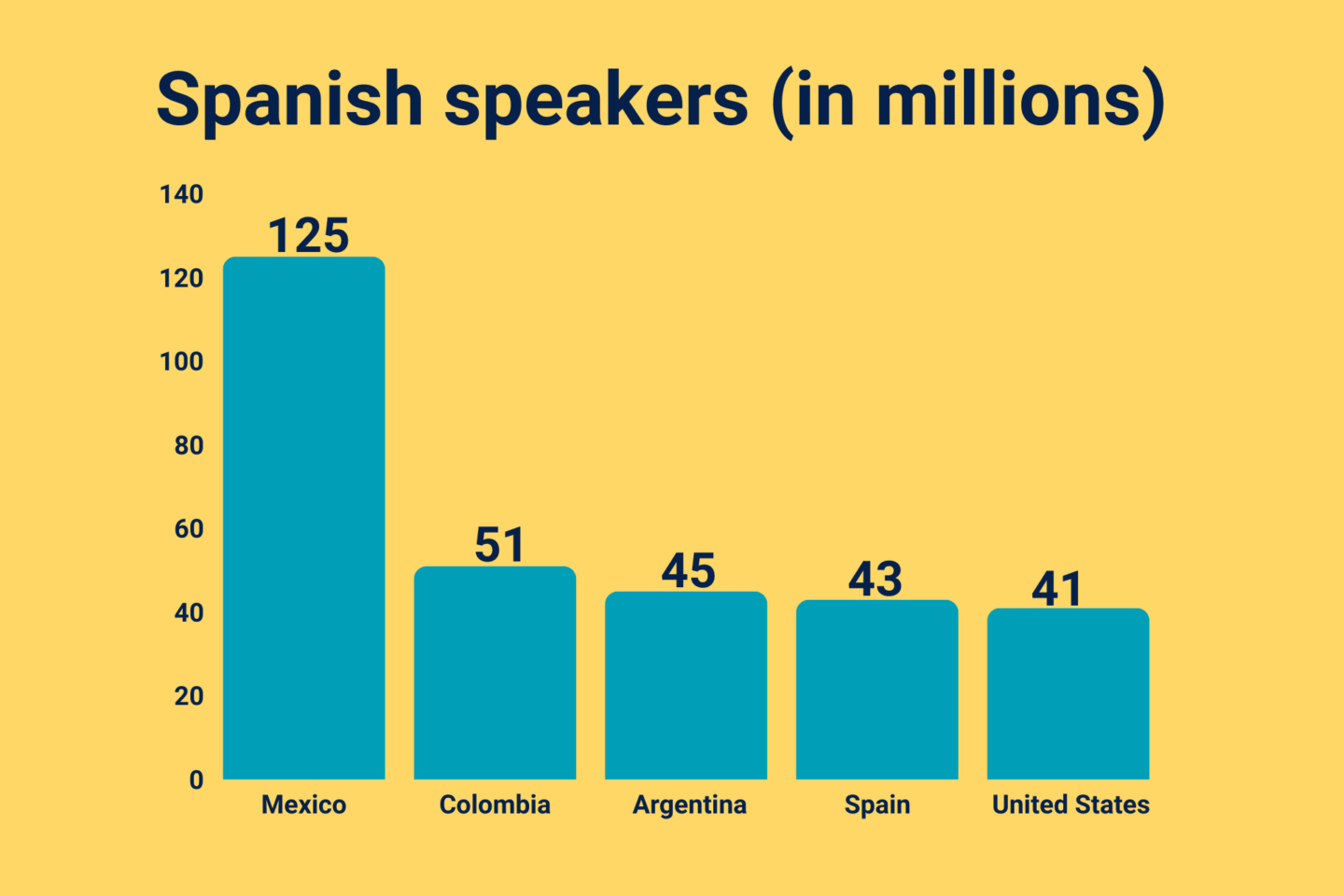Top 5 countries with the most Spanish speakers
Dedicated to celebrating the cultural and linguistic richness of the Spanish language, April 23rd marks Spanish Language Day. As the world’s second most spoken language, Spanish can be heard in a variety of songs, movies, and TV shows, captivating audiences with its rich and expressive vocabulary. Additionally, Spanish is a popular choice among language learners, being actively integrated into school curricula worldwide.
In this blog post, we will explore the Top 5 countries with the most Spanish speakers (as of 2024) – starting from Mexico and reaching two other continents. Each region has a sizeable Spanish-speaking community with a unique historical and cultural background; this diversity is reflected in the distinct variant of Spanish spoken in each region. So, which of the world’s countries are home to the largest Spanish-speaking communities?

Mexico (125 million Spanish speakers)
In Mexico, with nearly 130 million inhabitants, Spanish is the official and most widely spoken language. While Mexico is home to various native languages spoken by indigenous communities, Spanish currently stands as the dominant language of the region. Mexican Spanish developed through the colonisation of Mexico by Spain in the 16th century, where initially, the colonisers communicated with indigenous civilisations in their native languages; however, soon after Spanish gradually began dominating the linguistic space. While the Spanish spoken in Mexico somewhat differs from the Spanish spoken in Spain, Spaniards and Mexicans wouldn’t have a hard time understanding one another.
Did you know? In Mexican Spanish, the word ‘mano’ (derived from the Spanish ‘hermano’, meaning ‘brother’) is used to refer to a brother or a close friend. ‘Mano’ also happens to mean ‘hand’ in Spanish.
Colombia (51 million Spanish speakers)
Over 90% of the Colombian population speaks Spanish, although the country is linguistically diverse, with several Amerindian languages spoken within the region. Colombian Spanish differs from the Spanish spoken in Spain and varies among local regions; typically, Colombian Spanish refers to the variant spoken in and around the capital, Bogota. Historically, Colombia was home to numerous indigenous communities. However, once the Spanish explorers set foot in the region, several changes, including linguistic ones, occurred. Since then, Spanish established itself as the dominant language.
Did you know? An urban language known as ‘parlache’ originated in Medellín, Colombia.
Argentina (45 million Spanish speakers)
The Spanish language arrived in Argentina much like it did in Mexico and Colombia. Since the Spanish colonisation, Argentinian Spanish has undergone several changes and, as a result of language contact, developed into a separate variety that differs from Spanish spoken in other parts of Latin America. Around 90% of Argentinians speak Spanish; however, interestingly, the second most spoken language in the region is Italian, as more than half of the population has Italian roots. Due to this, Argentinian Spanish (often referred to as Rioplatense Spanish) has been influenced by Italian, particularly in terms of pronunciation.
Did you know? In the 19th and 20th centuries, immigrants who arrived from Italy to Argentina began speaking an Italian-Spanish pidgin called ‘Cocoliche’.
Spain (43 million Spanish speakers)
Spanish is the official language of Spain and is widely taught as a foreign language in European schools. The Spanish spoken in Peninsular Spain is referred to as ‘Peninsular Spanish’ or ‘Iberian Spanish,’ while the variety spoken in the Canary Islands is known as ‘Canarian Spanish.’ In Peninsular Spain, Spanish has a set of varieties that can be divided based on whether they are spoken in the northern or southern parts of the country. The northern dialect is known as ‘Castilian Spanish’; however, this term is often also used to refer to the standard form of Spanish. Each variety has been influenced by other languages spoken in a particular region. Spanish itself developed from the spoken form of Latin, thus making it a Romance language.
Did you know? In Iberian Spanish, the letter ‘z’ is pronounced similarly to the English ‘th’, while in Latin America, people pronounce it as ‘s’.
United States (41 million Spanish speakers)
The Spanish language has deep historical roots in the United States, predating the arrival of the English language by some time. Spanish was initially established by Spanish colonisers in regions like Florida and the Southwest and maintained a lasting presence despite the subsequent dominance of English. Today, Spanish is the second most spoken language as well as the most learned language (aside from English) in the U.S. Diverse contact situations have led to the development of unique dialect features in various varieties of Spanish across the country. Population data highlights that six U.S. states, including Arizona, Texas, Florida, California, New Mexico, and Nevada, have a population where at least 20% are speakers of Spanish.
Did you know? Words such as ‘potato’, ‘tomato’ and ‘ranch’ entered the American English vocabulary via Spanish.
